The proverb “know your quarry” applies to fly-fishing for tarpon as much as it does to hunting. The more you know, the better your odds are of finding them and coercing them to bite a hook bound with feathers, fibers and animal hair. Additionally, increasing your knowledge will inevitably build your respect and admiration for this remarkable fish.
Relative to other economically significant fish, tarpon have received little attention from the scientific community. However, there have been a handful of research projects dedicated to tarpon, and these have greatly increased our understanding of the silver king.
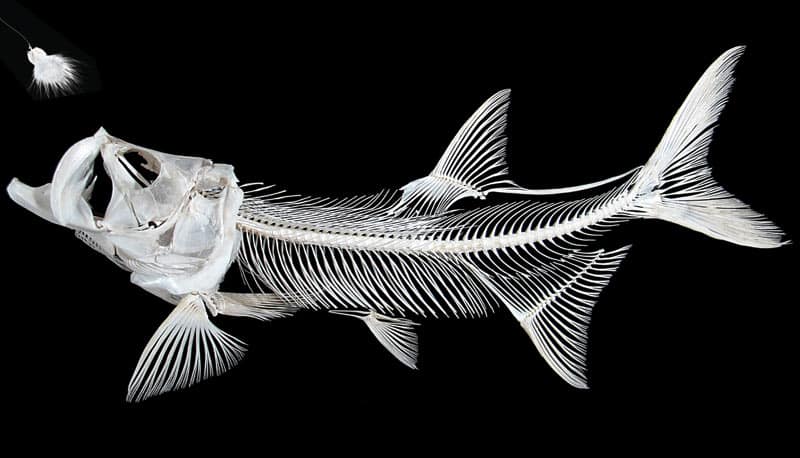
Fossil Record and Life History
While dinosaurs like T. rex and triceratops roamed terra firma during the Cretaceous Period (about 120 million years ago), ancestors of modern-day tarpon shared the ocean with other prehistoric fish. Mother Nature must have known a good thing when she saw it, because as far as evolution goes, the transformation of these early fish into Megalops atlanticus (the tarpon we pursue today) was complete about 18 million years ago. To put this in perspective, humans did not branch away from chimpanzee ancestors until 6 million years ago.
Despite spending the majority of their lives in coastal waters, tarpon actually begin life far from it. Spawning takes place offshore in the Gulf Stream waters of the Atlantic Ocean (about 20 miles east of Florida) and in the Gulf of Mexico (about 150 miles west of Florida). This has been verified through both satellite tagging and the capture of tarpon larvae. Tarpon have a unique larvae phase, called leptocephalus, that they share with bonefish, ladyfish and eels. In the first development stage, leptocephali have a limited ability to adjust for the ocean’s salty environment. Therefore, they must be born in waters with stable salinity. This explains why tarpon spawn offshore. If these leptocephali were in Florida Bay, the tide change would alter the salinity of the water and the larvae would die from either shrinking (in higher salinity) or exploding (in lower salinity). Ironically, scientists conducting research projects in the 1970s and 1980s tried to discover tarpon eggs and larvae by chasing nearshore tarpon schools. It was not until the 1990s that large numbers of larvae were discovered 150 miles west of St. Petersburg, Florida, in the Gulf of Mexico. Another interesting aspect of leptocephalus larvae is their unique behavior of being swimming machines that do not eat, as opposed to the larvae of, say, snapper or billfish, which feed immediately after birth. Instead, leptocephalus larvae have long, slender bodies and very low energy requirements, and they avoid predation by being transparent. During this phase, their teeth point outward and work similarly to a weed guard on a fly to prevent items from entering their mouth. There has been some discussion in scientific literature about whether the teeth are used to pierce jellyfish and suck out nutrients — but this is still a topic of debate.
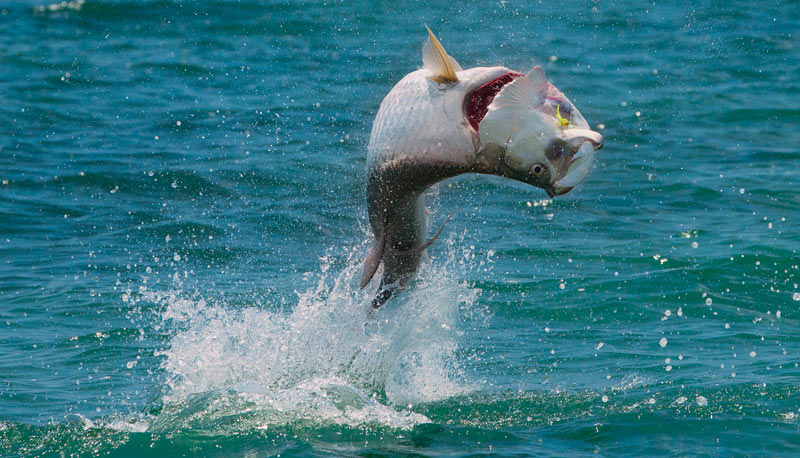
When leptocephali reach their final development stage, they swim inshore and settle in stagnant lagoons that act as nurseries for the young fish. Because these areas have poor water exchange, oxygen levels are low, which keeps out predatory species that require more oxygen, like sharks. Here juvenile tarpon thrive. Predators are limited, and tarpon can breathe by taking gulps of air from the surface and feed on other low-oxygen-requiring species, such as guppies, killifish and finger mullet. Anglers can use these nursery areas to their advantage. If you are fishing in the tropical waters of the west Atlantic, keep an eye out for stagnant bodies of water; you could very well find a good number of juvenile tarpon.
At the age of about 3, tarpon move out of the lagoons to find both more and larger prey. They spread out to a variety of nearshore habitats and have been documented to actually follow schools of mullet and other prey.
When tarpon reach sexual maturity around 8 years old, their growth and behavior change. Instead of primarily increasing in length, they increase in both length and girth. And they begin to join other mature tarpon in spawning aggregations. The growth rates are different for each sex. Males are smaller and rarely exceed 100 pounds. This is because males don’t need to have a large body to spawn as many times and with as many females as possible. Females, on the other hand, grow to larger sizes to produce and release as many eggs as possible. Think of eggs as marbles, and consider the number of marbles you can hold in a coffee mug versus fit in a five-gallon bucket. A larger container equals more eggs.
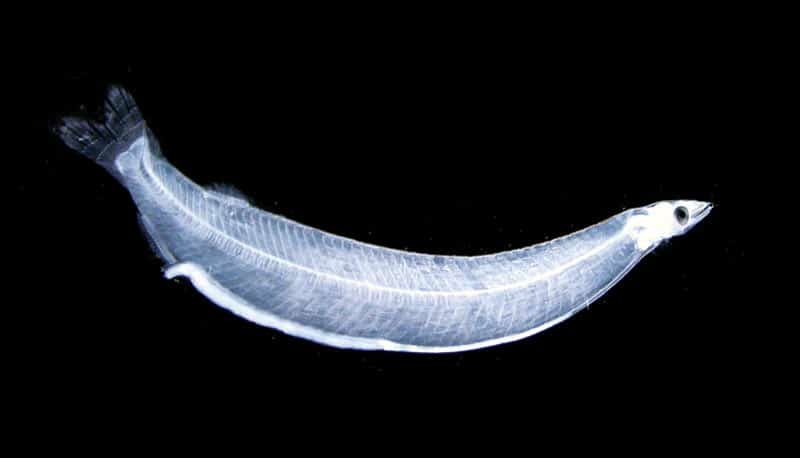
Morphology
Tarpon’s body structure helps them both capture and avoid becoming prey. Their forked tail permits fast, sustained swimming speeds and can propel them acrobatically out of the water, a virtue loved by fly-anglers. The upturned mouth of these fish has a massive gape that allows them to flare their gills to suck in water and inhale prey into their “bucket mouth.” Watching this process in action is precisely why many anglers pursue the silver king.
Tarpon have an interesting way of reducing mortality from predation. Most marine fish have spines to poke a predator when one attempts to consume them. Tarpon do not have spines but instead wear armor in the form of large, thick scales. A predator not only needs to catch these fast fish but also has to pierce the scale wall.
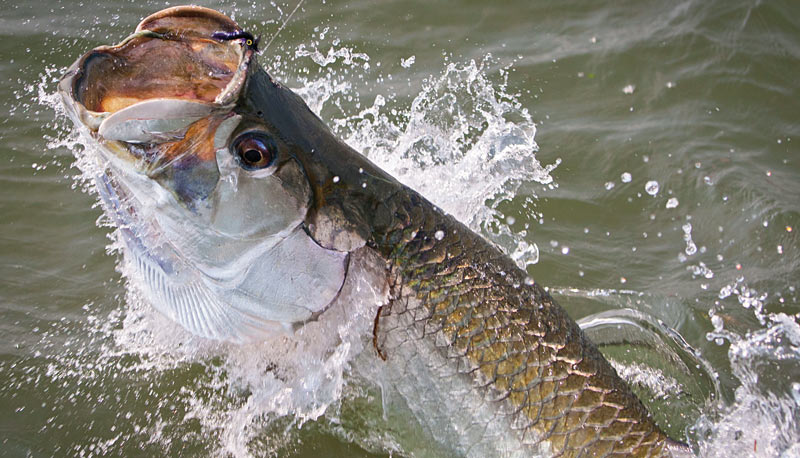
Visual Predator
When zoologist Achille Valenciennes first described tarpon in 1847, he noticed their large eyes, which ended up being the inspiration behind his choosing the scientific name of Megalops atlanticus, with Megalops meaning “large eye.” During daylight hours, this feature helps them see fine details, and at night, it increases their visual sensitivity, making them effective feeders 24/7. These large eyes also have a layer of cells that act much like a strip of reflective tape at the back of the eye.
This reflective tape, so to speak, maximizes the capture of light and has a high density of light-detecting rod cells, which give tarpon an advantage when feeding in turbid water or other lower-light conditions. This also explains why anglers often find tarpon hanging around shadows under mangroves and bridges. Essentially, in low-light conditions, tarpon can see the prey better than the prey can see them.
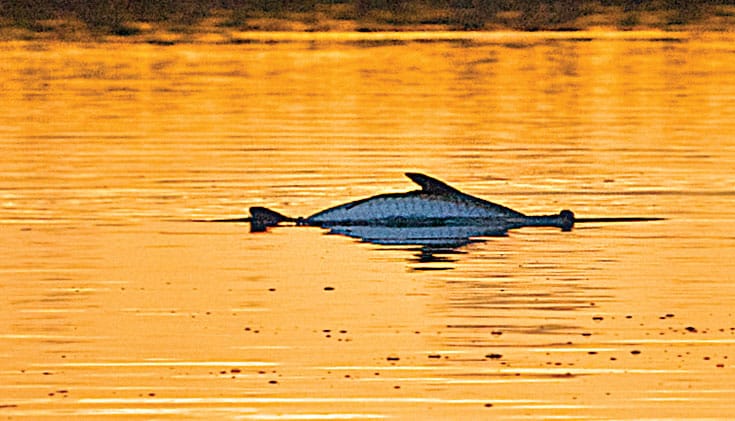
Research on the distribution of vision cells around a tarpon’s eye revealed their eyesight is keenest in upward and forward-looking regions. Combine this fact with the tarpon’s upward-turned mouth, and you realize the best placement for a fly is above and in front of a tarpon’s body.
The cone cells that determine what colors they see are another matter. First of all, fish eyes are very different from ours. Fish retinas contain stem cells that allow the density, distribution and function of vision cells to fluctuate throughout their life, whereas our eyes are static. This allows their eyes to change as the fish move into different habitats and potentially opt for different food sources. And this explains why some flies work for juveniles but not adults. As an example, the colors that juvenile tarpon see are different from those seen by adult specimens. Younger tarpon primarily pick up dark blue and a wide range of green colors. This is because they inhabit turbid waters with greater availability of longer wavelengths of light, like the green colors. When tarpon become adults, their ability to see this range decreases, and their vision in the shorter wavelengths, such as purples and blues, increases. They also develop cells to detect ultraviolet light. This is because when tarpon become adults, they spend more time in clear water, where shorter-wavelength and UV light are more abundant. It is unknown why tarpon see UV light, but there are a couple of possibilities. One is since some fish reflect UV light for communication, tarpon may use the ability to detect prey. Another is, with UV light so abundant in the shallow waters they inhabit, they may use this light to create a background, allowing them to detect the silhouettes of prey that would otherwise be camouflaged. This could explain why a 200-pound tarpon will hit a 3-inch fly.
Tarpon have no vision in the longer wavelengths of the color red, as red light is quickly absorbed in the marine environment. Red flies probably just look black to them in the water.
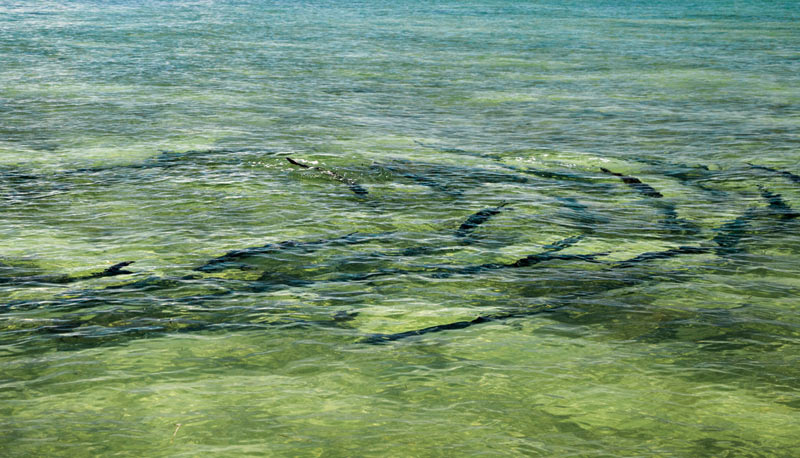
Migrations
Tagging projects have revealed remarkable tarpon migrations. Data collected from these efforts have shown tarpon moving over 2,000 miles and sometimes traveling as many as 20 miles in a day. In spring and early summer, they aggregate to prepare for or partake in spawning activities. May, June and July are the spawning months for tarpon in Florida, and satellite tagging has discovered tarpon during this time making brief trips to the Gulf Stream and diving to depths greater than 400 feet. We still don’t know why they make these dives, but they are believed to be related to spawning activity. After spawning, tarpon display a snowbird-type behavior by moving north during late summer and then back south when the coastal ocean waters cool in the fall. These movements correlate with temperature, with tarpon staying in 79-degree-Fahrenheit waters as they move north and south. Their overwintering locations are still a mystery because only a handful of locations have consistently held tarpon in the winter. It’s still unknown where the mother lode of tarpon reside during the winter. Recent research has found them greater than 20 miles from land in the Gulf of Mexico. There are even recent reports of tarpon overwintering on Louisiana oil rigs.
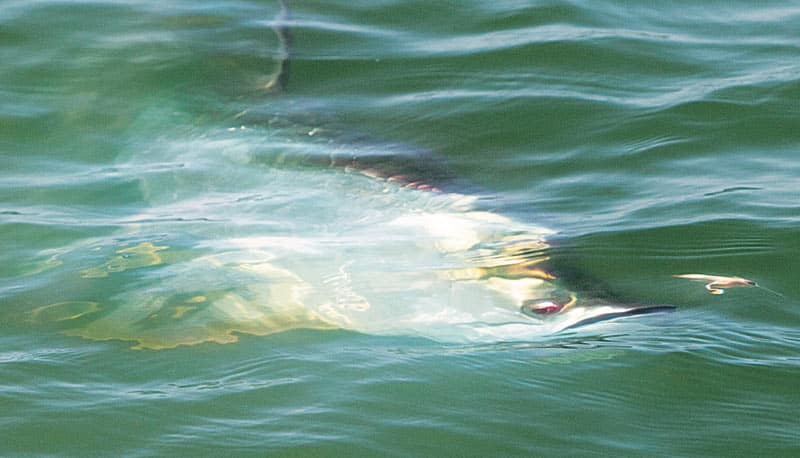
Rolling Tarpon
A tarpon’s gut is connected to its swim bladder, allowing the fish to swallow air from the surface. Once the air reaches the swim bladder, oxygen is removed by lung-like tissue called alveolar. This unique air-breathing swim bladder gives tarpon the advantage of obtaining oxygen not only from the water but also from the air above it. Tarpon can actually switch between the two methods as conditions require. For example, the primary organ for obtaining oxygen in water with normal oxygen levels is the gills; however, in water with low oxygen levels, the primary breathing organ is the swim bladder. This explains why sunrise is an excellent time to fish for rolling tarpon. At this time, oxygen levels are lowest because photosynthesis (a chemical reaction requiring light to produce carbohydrates and oxygen) stops during the night. This forces tarpon to roll more frequently to meet their oxygen demand.
One of the advantages of tarpon’s air-breathing behavior is rapid recovery of oxygen debt, as the oxygen level in air is higher than it is in water. This explains why tarpon roll at the surface during an extended fight. Their air-breathing ability, combined with their extensive gill surface area, also reveals exactly how tarpon are capable of these long fights.
Water temperature plays a part in the frequency of tarpon rolling too. In water at or above 79 degrees, a tarpon will roll more often to adjust for its elevated metabolism and the lower oxygen concentration. You can use this information to determine tarpon abundance. If you are fishing in waters 79 degrees or higher and don’t see any tarpon rolling, it’s a safe assumption that they are not in the area. Move on.









